Soft corals (phylum Cnidaria, class Anthozoa, subclass Octocorallia, order Alcyonacea) are radially symmetrical animals connected to each other by a fleshy tissue (instead of a calcareous skeleton found in hard corals). Like other cnidarians, they possess explosive, harpoon-like cells called cnidocytes. Each cnidocyte contains a secretory organelle (cnidae), which can be a nematocyst that discharges a harpoon-like stinger carrying toxins, a ptychocyst that discharges sticky substances, or a spirocyst that discharges lasso-like threads. Hence while cnidocytes are often called "stinging cells", they do perform other functions apart from stinging. Many soft corals can also secrete chemicals to deter other organisms from competing for space with them.

The coral animal, or polyp, has a simple body comprising a stomach (coelenteron) and a mouth surrounded by tentacles (where most of the cnidocytes are located), appearing like a little flower. The tentacles occur in multiples of eight, and hence they are in the subclass Octocorallia. It does not have an anus, and thus the mouth performs both functions of ingesting food and removing waste.

Colonies of soft corals may cover extensive areas of the coral reef. The rigidity of the colonies are usually maintained by a hydrostatic pressure system, which is basically water pumped through the colony. They also often have tiny spiky particles called sclerites to provide support for the tissues.
Many soft corals harbour the unicellular algae, zooxanthellae, inside their tissues, which give them a brownish colour. The zooxanthellae produce food through photosynthesis and share the food with the host corals, and in return get shelter and nutrients (waste products of the corals). Soft corals also actively feed on plankton with their tentacles.

Sometimes, the corals may expel their zooxanthellae or the latter may leave the coral due to environmental stress, resulting in a phenomenon known as coral bleaching. Without the zooxanthellae giving the corals their base colour, the corals turn white and appear bleached. One of the main causes of coral bleaching is the rise in water temperatures. If the situation does not improve and the soft corals cannot recruit new zooxanthellae to replace the lost ones, they may die.

Soft corals can reproduce sexually or asexually. In sexual reproduction, some species broadcast their eggs and sperm into the sea in mass synchronous spawning, while others fertilise their eggs internally. The fertilised egg develops into a free-swimming larva, which will cement itself onto a suitable hard substrate, builds a corallite, secretes a hard skeleton, and eventually clones itself to form a colony. In asexual reproduction, the polyp can split into two (intratenacular budding), or a new clone may grow from the base of an existing polyp (extratentacular budding).

Many soft corals have two types of polyps: autozooids, the feeding polyps, which usually have 8 feather-like tentacles (inset; and contracted stalk-like structures in main picture); and siphonozooids, the water intake polyps, which are usually greatly reduced in size, and their tentacles are rudimentary (flower-like structures carpeting the areas around the stalk-like autozooids in main picture).
Much of my knowledge on soft coral identification was gained from marine biologist Ong Joo Yong (thanks a million, Joo Yong!). My knowledge is still quite limited though, and hence I can only try to identify many of them to their genera. So if you find any mistakes below, do let me know!
A) SUBORDER ALCYONIINA
Family Alcyoniidae
Alcyoniid soft corals usually have tiny polyps housed in a shared leathery tissue, and hence they are comonly called leathery soft corals. Depending on the genus, they may either have both autozooids (with long trunks and eight tiny branched tentacles) and siphonozooids (which remain below the leathery surface, appearing as tiny holes or mounds), or only autozooids. The autozooids usually only emerge when the colony is fully submerged. Most species harbour zooxanthellae, and the colonies are mostly massive, though some may appear encrusting.

Sarcophyton spp. are usually somewhat mushroom-shaped, and hence they are sometimes called toadstool leather corals. The mushroom-shaped colony comprises a disc-shaped structure called the polyparium (which carries the polyps) sitting on a stem-like structure. The polyparium usually have open folds on its margin. The polyps are dimorphic, meaning there are both autozooids and siphonozooids. When submerged, the long, tubular autozooids will emerge, while the small siphonozooids remain as small bumps on the leathery surface. They harbour zooxanthellae.

Lobophytum spp., commonly called the lobed leather corals, also have a disc-like polyparium sitting on a stem, but the polyparium comes with vertical lobes, ridges or finger-like structures. It also has both types of polyps, and the autozooids are often white in colour. These soft corals harbour zooxanthellae as well.
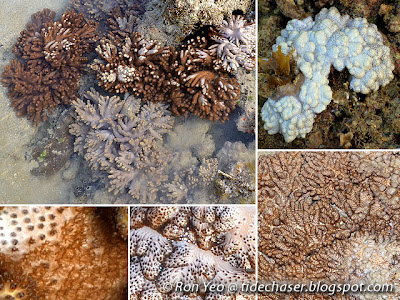
Cladiella spp., sometimes called blushing finger leather corals, form comparatively small colonies as they usually divide into several separate colonies on reaching certain sizes. The colonies often have a small stalk, and the polyparium is covered with numerous finger-like or knob-like lobes. They only have autozooids, which usually do not retract completely into the fleshy tissue, which has lots of sclerites. A drastic colour change is observed when the brown-coloured polyps retract to reveal the white-colour fleshy tissue, giving it a whitish appearance marked with small dark spots (the partially retracted polyps). ) They harbour zooxanthellae in their tissue.
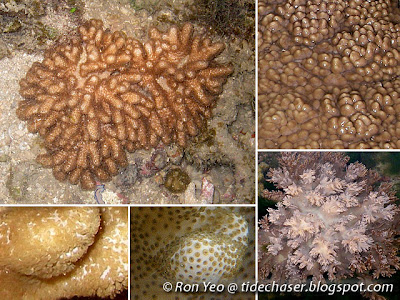
Sinularia spp., sometimes called dead men's fingers, usually form massive colonies with numerous finger-like projections on the polyparium. They only have autozooids, and the layer of tiny polyps give the colony a furry appearance. The lack of siphonozooids gives the colony a smoother texture compared with most other leather corals. They harbour zooxanthellae as well.
Family Nephtheidae
Nephtheid soft corals usually appear tree-like corals with a main stem and many branches. They have long, canal-like chambers which can be filled with water, allowing the colony to stay firm and erect to bigger sizes for stability. When disturbed, they are able to release water from the chambers in their stem quickly so as to shrink to smaller sizes.

Litophyton spp. and Nephthea spp. (also spelled as Nephthya sometimes), are bush- or tree-like with their branched polyparium. The polyps are arranged in clumps on the terminal branches, and while they can close (or contract), they cannot retract into the branches. On the lower sides of the polyps, supporting bundles of pointed spindle-shaped sclerites can be seen in Nephthea, but not Litophyton. Recent phylogenetic studies, however, have suggested that Nephthea soft corals should be synonymised with the Litophyton genus. Pending this to be more widely accepted, it is probably acceptable to say all the above are Litophyton spp. Zooxanthellae are present in both genera.

Stereonephthya spp. are also bush- to tree-like. The polyps occur in bundles directly on the stem and the few secondary branches with supporting bundles. They usually feel very spiky and firm when touched, and while they can contract, they do not retract completely into the branch. On the stem surface, numerous sclerites of a contrasting colour can be seen. They do not host zooxanthellae. Recent phylogenetic studies, however, have shown that some Stereonephthya species should be Nephthea species instead.

Dendronephthya spp. also have no zooxanthellae. The colonies usually appear tree or bush-like, and the polyps occur in bundles (no catkins). Each polyp has a supporting bundle of sclerites, and on the stem surface, sclerites of a contrasting colour can be seen. Recent studies suggest that they should be a junior synonym of Litophyton as well. are branched, on surface sclerites can be seen, which are contrastingly coloured.
Family Xeniidae
Xeniid corals usually occur as small groups between populations of hard corals. They mostly have long polyps extending from a short and stem-like common body mass, though in some cases, this body mass is reduced to a thin basal crust. The digestive tracts of the polyps are usually much reduced, and hence they mostly rely on the zooxanthellae in their tissue to provide most of their nutritional requirements. It is suggested that they can absorb organic compounds from the surrounding water as well.
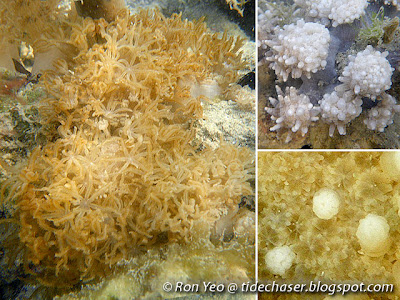
Heteroxenia spp. have both types of polyps - the autozooids (the long polyps) and siphonozooids (the smaller flower-like polyps carpeting the surface). The juveniles, however, lack siphonozooids, and may be difficult to identify. The colonies are usually upright, with long, flower-like polyps. The polyps can contract, but do not retract completely into the stalk. As mentioned earlier, they rely mostly on the zooxanthellae for nutrition.

Xenia spp. also form upright colonies with long, flower-like polyps. They only have autozooids, and this can be easily seen when the polyps contract - they lack the carpeting siphonozooids. Like the previous genus, the polyps cannot retract into the stalk. Interestingly, the feather-like tentacles are often seen pulsating, possibly to improve the exchange of oxygenated water. The specimens I have seen in local waters also tend to have a brighter colour compared to those from the previous genus. They are highly dependent on the zooxanthellae in their tissues.

Sansibia spp. have polyps arising from soft spreading membranes or ribbon-like horizontal branches (stolons). They only have autozooids, and the polyps can contract but do not retract into the membranes or stolons. Hence, they often appear as blue or green patches on the substrate when they are exposed during low tide. Like other xeniids, they have zooxanthellae in their tissues.
B) SUBORDER HOLAXONIA, CALCAXONIA & SCLERAXONIA
These three suborders were previously placed under the order Gorgonacea, which has been synonymised with the order Alcyonacea.
Family Briareidae
This family only has one genus - Briareum. The only other genus previously placed under this family have been synonymised.

Briareum spp. form encrusting colonies with short cylindrical tubes housing the autozooids - they do not have siphonozooids. The colonies have a soft and furry carpet-like appearance when the polyps are extended. When the polyps retract into the cylindrical tubes, the bottom crust (coenenchyme) is revealed. Sometimes, they can cover living structures such as sea fans or hard corals, and assume their shape. They harbour zooxanthellae in their tissues.
Family Ellisellidae
Ellisellid soft corals may form whip-like, bushy, or fan-like colonies with a calcified solid axis exhibiting a radial pattern in cross section.

Junceella spp. occur in unbranched, whip-like colonies, and hence they are commonly called sea whips. It has no zooxanthellae.

Ctenocella pectinata forms colonies branching in one plane, appearing comb-like or lyre-like. It has no zooxanthellae as well.

Dichotella spp. form colonies which are dichotomously branched. They may appear bushy or fan-like, but generally the branches are whip-like. They lack zooxanthellae as well.
Other Sea Fans
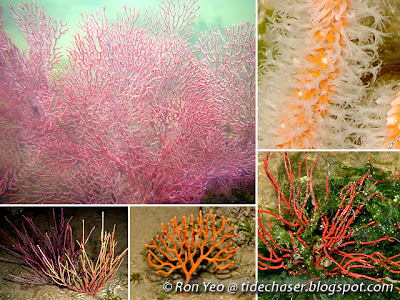
Many other species of gorgonians can be seen in local waters, but unfortunately my knowledge of sea fan identification is too limited to identify them, and I do not have friends who are familiar enough with this group to provide tips on the identification. Hopefully I will eventually get to know someone who can help me with this! :)
C) SUBORDER STOLONIFERA
Family Clavulariidae
Clavulariid soft corals do not form colonies with a thick common tissue. Instead, they either form encrusting colonies with polyps joined at the base by root-like creepers (stolons), or bushy colonies with branches connected the polyps.
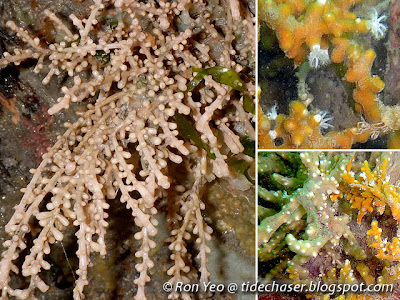
Carijoa spp. form small bush-like colonies, with long primary polyps producing many secondary polyps by lateral budding. They usually occur at shady areas, such as under jetties, in caves or under overhanging coral colonies. Sometimes, the colonies may be overgrown with encrusting sponges, such as the ones in the insets which are covered with orange and light brown sponges. They have light coloured polyps, and lack zooxanthellae.
References

The coral animal, or polyp, has a simple body comprising a stomach (coelenteron) and a mouth surrounded by tentacles (where most of the cnidocytes are located), appearing like a little flower. The tentacles occur in multiples of eight, and hence they are in the subclass Octocorallia. It does not have an anus, and thus the mouth performs both functions of ingesting food and removing waste.

Colonies of soft corals may cover extensive areas of the coral reef. The rigidity of the colonies are usually maintained by a hydrostatic pressure system, which is basically water pumped through the colony. They also often have tiny spiky particles called sclerites to provide support for the tissues.
Many soft corals harbour the unicellular algae, zooxanthellae, inside their tissues, which give them a brownish colour. The zooxanthellae produce food through photosynthesis and share the food with the host corals, and in return get shelter and nutrients (waste products of the corals). Soft corals also actively feed on plankton with their tentacles.

Sometimes, the corals may expel their zooxanthellae or the latter may leave the coral due to environmental stress, resulting in a phenomenon known as coral bleaching. Without the zooxanthellae giving the corals their base colour, the corals turn white and appear bleached. One of the main causes of coral bleaching is the rise in water temperatures. If the situation does not improve and the soft corals cannot recruit new zooxanthellae to replace the lost ones, they may die.

Soft corals can reproduce sexually or asexually. In sexual reproduction, some species broadcast their eggs and sperm into the sea in mass synchronous spawning, while others fertilise their eggs internally. The fertilised egg develops into a free-swimming larva, which will cement itself onto a suitable hard substrate, builds a corallite, secretes a hard skeleton, and eventually clones itself to form a colony. In asexual reproduction, the polyp can split into two (intratenacular budding), or a new clone may grow from the base of an existing polyp (extratentacular budding).

Many soft corals have two types of polyps: autozooids, the feeding polyps, which usually have 8 feather-like tentacles (inset; and contracted stalk-like structures in main picture); and siphonozooids, the water intake polyps, which are usually greatly reduced in size, and their tentacles are rudimentary (flower-like structures carpeting the areas around the stalk-like autozooids in main picture).
Much of my knowledge on soft coral identification was gained from marine biologist Ong Joo Yong (thanks a million, Joo Yong!). My knowledge is still quite limited though, and hence I can only try to identify many of them to their genera. So if you find any mistakes below, do let me know!
A) SUBORDER ALCYONIINA
Family Alcyoniidae
Alcyoniid soft corals usually have tiny polyps housed in a shared leathery tissue, and hence they are comonly called leathery soft corals. Depending on the genus, they may either have both autozooids (with long trunks and eight tiny branched tentacles) and siphonozooids (which remain below the leathery surface, appearing as tiny holes or mounds), or only autozooids. The autozooids usually only emerge when the colony is fully submerged. Most species harbour zooxanthellae, and the colonies are mostly massive, though some may appear encrusting.

Sarcophyton spp. are usually somewhat mushroom-shaped, and hence they are sometimes called toadstool leather corals. The mushroom-shaped colony comprises a disc-shaped structure called the polyparium (which carries the polyps) sitting on a stem-like structure. The polyparium usually have open folds on its margin. The polyps are dimorphic, meaning there are both autozooids and siphonozooids. When submerged, the long, tubular autozooids will emerge, while the small siphonozooids remain as small bumps on the leathery surface. They harbour zooxanthellae.

Lobophytum spp., commonly called the lobed leather corals, also have a disc-like polyparium sitting on a stem, but the polyparium comes with vertical lobes, ridges or finger-like structures. It also has both types of polyps, and the autozooids are often white in colour. These soft corals harbour zooxanthellae as well.

Cladiella spp., sometimes called blushing finger leather corals, form comparatively small colonies as they usually divide into several separate colonies on reaching certain sizes. The colonies often have a small stalk, and the polyparium is covered with numerous finger-like or knob-like lobes. They only have autozooids, which usually do not retract completely into the fleshy tissue, which has lots of sclerites. A drastic colour change is observed when the brown-coloured polyps retract to reveal the white-colour fleshy tissue, giving it a whitish appearance marked with small dark spots (the partially retracted polyps). ) They harbour zooxanthellae in their tissue.

Sinularia spp., sometimes called dead men's fingers, usually form massive colonies with numerous finger-like projections on the polyparium. They only have autozooids, and the layer of tiny polyps give the colony a furry appearance. The lack of siphonozooids gives the colony a smoother texture compared with most other leather corals. They harbour zooxanthellae as well.
Family Nephtheidae
Nephtheid soft corals usually appear tree-like corals with a main stem and many branches. They have long, canal-like chambers which can be filled with water, allowing the colony to stay firm and erect to bigger sizes for stability. When disturbed, they are able to release water from the chambers in their stem quickly so as to shrink to smaller sizes.

Litophyton spp. and Nephthea spp. (also spelled as Nephthya sometimes), are bush- or tree-like with their branched polyparium. The polyps are arranged in clumps on the terminal branches, and while they can close (or contract), they cannot retract into the branches. On the lower sides of the polyps, supporting bundles of pointed spindle-shaped sclerites can be seen in Nephthea, but not Litophyton. Recent phylogenetic studies, however, have suggested that Nephthea soft corals should be synonymised with the Litophyton genus. Pending this to be more widely accepted, it is probably acceptable to say all the above are Litophyton spp. Zooxanthellae are present in both genera.

Stereonephthya spp. are also bush- to tree-like. The polyps occur in bundles directly on the stem and the few secondary branches with supporting bundles. They usually feel very spiky and firm when touched, and while they can contract, they do not retract completely into the branch. On the stem surface, numerous sclerites of a contrasting colour can be seen. They do not host zooxanthellae. Recent phylogenetic studies, however, have shown that some Stereonephthya species should be Nephthea species instead.

Dendronephthya spp. also have no zooxanthellae. The colonies usually appear tree or bush-like, and the polyps occur in bundles (no catkins). Each polyp has a supporting bundle of sclerites, and on the stem surface, sclerites of a contrasting colour can be seen. Recent studies suggest that they should be a junior synonym of Litophyton as well. are branched, on surface sclerites can be seen, which are contrastingly coloured.
Family Xeniidae
Xeniid corals usually occur as small groups between populations of hard corals. They mostly have long polyps extending from a short and stem-like common body mass, though in some cases, this body mass is reduced to a thin basal crust. The digestive tracts of the polyps are usually much reduced, and hence they mostly rely on the zooxanthellae in their tissue to provide most of their nutritional requirements. It is suggested that they can absorb organic compounds from the surrounding water as well.

Heteroxenia spp. have both types of polyps - the autozooids (the long polyps) and siphonozooids (the smaller flower-like polyps carpeting the surface). The juveniles, however, lack siphonozooids, and may be difficult to identify. The colonies are usually upright, with long, flower-like polyps. The polyps can contract, but do not retract completely into the stalk. As mentioned earlier, they rely mostly on the zooxanthellae for nutrition.

Xenia spp. also form upright colonies with long, flower-like polyps. They only have autozooids, and this can be easily seen when the polyps contract - they lack the carpeting siphonozooids. Like the previous genus, the polyps cannot retract into the stalk. Interestingly, the feather-like tentacles are often seen pulsating, possibly to improve the exchange of oxygenated water. The specimens I have seen in local waters also tend to have a brighter colour compared to those from the previous genus. They are highly dependent on the zooxanthellae in their tissues.

Sansibia spp. have polyps arising from soft spreading membranes or ribbon-like horizontal branches (stolons). They only have autozooids, and the polyps can contract but do not retract into the membranes or stolons. Hence, they often appear as blue or green patches on the substrate when they are exposed during low tide. Like other xeniids, they have zooxanthellae in their tissues.
B) SUBORDER HOLAXONIA, CALCAXONIA & SCLERAXONIA
These three suborders were previously placed under the order Gorgonacea, which has been synonymised with the order Alcyonacea.
Family Briareidae
This family only has one genus - Briareum. The only other genus previously placed under this family have been synonymised.

Briareum spp. form encrusting colonies with short cylindrical tubes housing the autozooids - they do not have siphonozooids. The colonies have a soft and furry carpet-like appearance when the polyps are extended. When the polyps retract into the cylindrical tubes, the bottom crust (coenenchyme) is revealed. Sometimes, they can cover living structures such as sea fans or hard corals, and assume their shape. They harbour zooxanthellae in their tissues.
Family Ellisellidae
Ellisellid soft corals may form whip-like, bushy, or fan-like colonies with a calcified solid axis exhibiting a radial pattern in cross section.

Junceella spp. occur in unbranched, whip-like colonies, and hence they are commonly called sea whips. It has no zooxanthellae.

Ctenocella pectinata forms colonies branching in one plane, appearing comb-like or lyre-like. It has no zooxanthellae as well.

Dichotella spp. form colonies which are dichotomously branched. They may appear bushy or fan-like, but generally the branches are whip-like. They lack zooxanthellae as well.
Other Sea Fans

Many other species of gorgonians can be seen in local waters, but unfortunately my knowledge of sea fan identification is too limited to identify them, and I do not have friends who are familiar enough with this group to provide tips on the identification. Hopefully I will eventually get to know someone who can help me with this! :)
C) SUBORDER STOLONIFERA
Family Clavulariidae
Clavulariid soft corals do not form colonies with a thick common tissue. Instead, they either form encrusting colonies with polyps joined at the base by root-like creepers (stolons), or bushy colonies with branches connected the polyps.

Carijoa spp. form small bush-like colonies, with long primary polyps producing many secondary polyps by lateral budding. They usually occur at shady areas, such as under jetties, in caves or under overhanging coral colonies. Sometimes, the colonies may be overgrown with encrusting sponges, such as the ones in the insets which are covered with orange and light brown sponges. They have light coloured polyps, and lack zooxanthellae.
References
- Chou, L. M. 1998. A Guide to the Coral Reef Life of Singapore. Singapore Science Centre. 128 pp.
- Erhardt, H. and D. Knop. 2005. Corals: Indo-Pacific Field Guide. IKAN-Unterwasserachiv, Frankfurt. 305 pp.
- ETI BioInformatics. 2012. Marine species identification portal. Retrieved Dec 29, 2012, from http://species-identification.org.
- Goh, N. K. C. and L. M. Chou. 1996. An annotated checklist of the gorgonians (Anthozoa: Octocorallia) of Singapore, with a discussion of gorgonian diversity in the Indo-West Pacific. The Raffles Bulletin of Zoology 44 (2): 435-459
- Ofwegen, L.P. van, and D.S.J. Groenenberg. 2007. A centuries old problem in nephtheid taxonomy approached using DNA data (Coelenterata: Alcyonacea). Contributions to Zoology, 76(3): 153-178.
- Ruppert, E.E. and R.D. Barnes. 1991. Invertebrate Zoology (International Edition). Saunders College Publishing. U.S.A. 1056 pp.
- World Register of Marine Species. 2012. Retrieved Oct 3, 2012, from http://www.marinespecies.org.

No comments:
Post a Comment